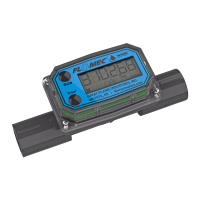26
OPERATION (continued)
USER CONFIGURATION MODE (Advanced Options) (continued)
DAUGHTER BOARD MODULES (continued)
4-20mA Menu (Requires 4-20mA Daughter Board Module) (continued)
NOTE: Figure 29-4 shows the display when
changing “span” or 20mA Flowrate Settings.
Figure 29-4
USER CONFIGURATION MODE (Field Calibration Mode)
Field Calibration Method
General
The field calibration method may be set by the user, and can be changed or modified at any
time using a field calibration method described in this section. Totals or flowrate derived from
the field calibration are being invoked when the (FAC) icon is no longer visible below the 6-
digit display.
Factory calibration settings are programmed into each computer during manufacturing, using
Stoddard test solvent at 70° F (21° C) for meters up to 1 inch. Meters 1-1/2 inch and larger
are factory calibrated using water at 70° F (21° C).
Settings are correct for light liquids such as water, gasoline or diesel. Readings using the
factory calibration (FAC) may not be accurate in some situations, for example, "heavy" liquids
such as motor oil, under extreme temperature conditions, non-standard plumbing
configurations or with fluids other than those mentioned above.
For improved accuracy under such conditions, the computer allows for field calibration, that
is, user entry of custom calibration parameters. A "single point" field calibration curve may
yield acceptable accuracy when used in a non-standard application; however, the computer
is capable of programming a “five point” field calibration curve.
NOTE: If the calibration method is changed when in user configuration mode, i.e., not using
the default factory calibration (FAC), the programming will allow the user to adjust the user
programmable calibration table for the calibration method selected. This is done by shunting
the user to the field calibration method entry menu specific to that calibration method upon
exit from the user configuration mode.
Verify Accuracy before Beginning Field Calibration
For the most accurate results, dispense at a flowrate which best simulates your actual
operating conditions. Avoid "dribbling" more fluid or repeatedly starting and stopping the flow.
This can result in less accurate calibrations. Make sure you meet the meter's minimum
flowrate requirements.
The use of a uniformly dependable, accurate calibration container is recommended for the
most accurate results. A five-gallon calibration container is available in the parts section of
this manual. For best results, the meter should be installed and purged of air before field
calibration.
Due to high flowrates on meters 2 inch and larger, it is strongly recommended that field
calibration be completed with a combination of volume and weight determined with fine
resolution scales.

